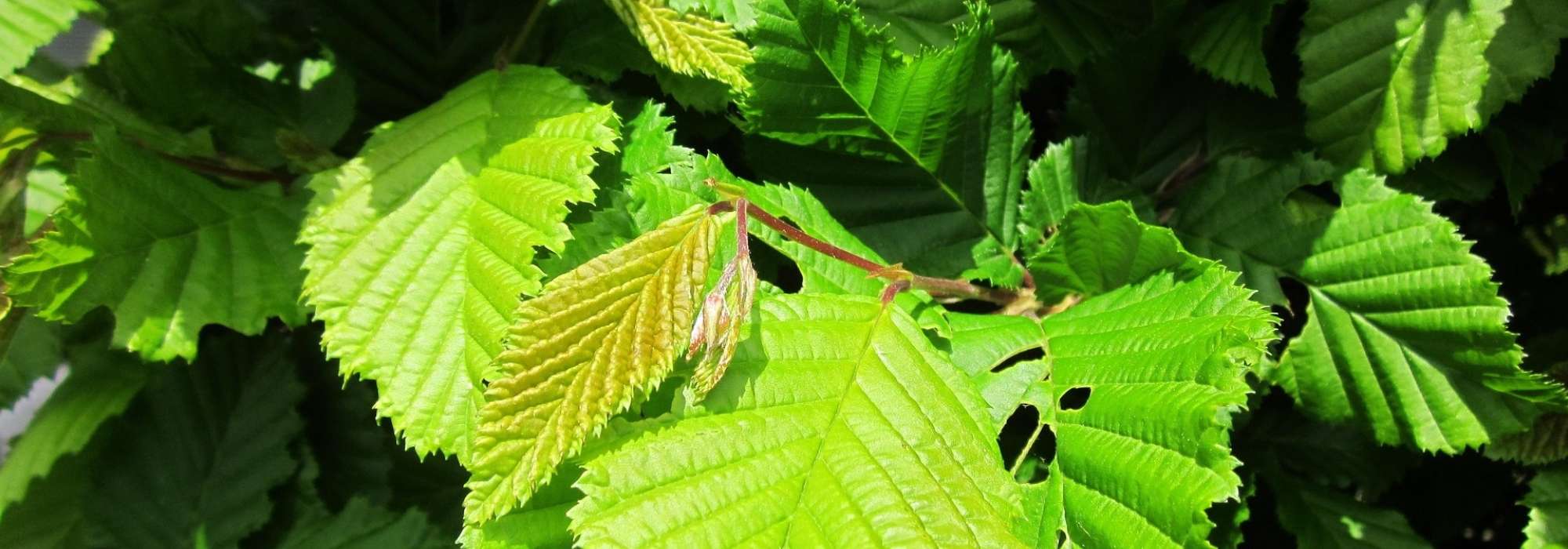
Hornbeam, hornbeam hedge: planting, pruning and maintaining
Contents
The Charm
- Hornbeam is a low-competition forest tree that tolerates shade and the proximity of dominant trees such as oaks and beeches.
- The dentate foliage in fresh spring green takes on a caramel hue in autumn before falling.
- When planted alone, it becomes a beautiful spreading or fastigiate tree up to 15 m tall, but it also associates with its peers to form a trimmed hornbeam hedge as desired.
- It is a tree with a lifespan exceeding a century and is highly resistant to diseases.
- Easy to cultivate and very cold-resistant, it particularly enjoys heavy, clayey soils.
A word from our expert
Hornbeam is a common tree, native to our temperate forests. It goes by the sweet Latin name of Carpinus betulus, also known as the Birch hornbeam or Common hornbeam. This species, originating from Europe, prefers heavy clay soils and even moist conditions like those found in Normandy, which other plants tend to dislike. Other species of hornbeams can be found in America, Japan, and beyond. The common hornbeam grows into a medium-sized tree, reaching heights of 15-20 m, but in cultivation, it often limits itself to 9 m tall and 5 m wide.
It is particularly easy to incorporate into our gardens as it handles pruning exceptionally well and makes for formidable impenetrable hedges within three years, known as charmilles. Both fresh and aesthetically pleasing, they are highly malleable and easy to maintain due to numerous branches that remain relatively thin. It is easy to shape the bush to your liking, limiting the thickness of a hedge to 50 cm wide, creating tunnels or arches, making openings in the hedge, developing topiaries, or even imagining a maze as was done in French gardens. The planting distance influences the vigour of the trees, so the closer you plant them to constrain their size, the more you need to plant tightly!
Another characteristic of the hornbeam is that the shedding of leaves does not result in any chore of collection as the degradation is rapid, leading to fertilisation of the soil in the process. The fresh light green tones in season transform into an amber or golden colour in autumn before turning chestnut brown due to the drying of the tissues, revealing the architecture of the trunks and the grey-brown branches. The hedge remains sufficiently opaque to form an impenetrable barrier while allowing the gentle rays of winter and a light breeze to pass through. Its role as a windbreak is even enhanced compared to a wall or an evergreen hedge, as it prevents the presence of convection currents behind the hedge. Pruning is much easier than with thujas or cypresses and produces less waste, which can easily be recycled as B.R.F (chipped shoots converted into fertilising mulch).
Description and Botany
Botanical data
- Latin name Carpinus betulus
- Family Betulaceae
- Common name Hornbeam
- Flowering from March to April
- Height between 9 and 15 m
- Sun exposure full sun or partial shade or shade
- Soil type any deep soil, even calcareous, rather cool and not too acidic
- Hardiness Excellent (-20 °C)
Le genre Carpinus comprend 40 espèces d’arbres caducs disséminés uniquement dans les climats tempérés frais de l’hémisphère nord. Ce sont des arbres dont la floraison se présente sous forme de chatons unisexués comme chez le Bouleau, l’Aulne, le Noisetier ou le Charme-houblon (Ostrya) qui font partie de la même famille des Bétulacées. Les charmes présentent un feuillage très semblable entre eux, même si leur taille varie, ainsi qu’une fructification caractéristique en forme des grappes pendantes composées de fruits ailés superposés. Les espèces diffèrent essentiellement par le port et les dimensions de l’arbre. Comme le hêtre, le charme présente pendant très longtemps une écorce fine lisse et grise mais le tronc forme ici des cannelures verticales qui chez les vieux arbres créent des plis ou fissures dans lesquels on peut glisser des mots tendres. L’écorce des arbres âgés se fendille et produit de longues écailles peu épaisses.

Carpinus betulus – botanical illustration
Le feuillage alterne est par ailleurs qualifié de marcescent, puisqu’il persiste sur les rameaux durant tout l’hiver, et ne se détache que sous l’impulsion des nouvelles pousses printanières. Il est composé de feuilles ovales et dentées, de 7 à 12 cm de long. La couleur vert clair très tendre devient mordorée à l’automne, orange foncé-rouge chez Carpinus betulus Rockhampton Red ou encore chez l’espèce américaine Carpinus caroliniana avant de se dessécher affichant des tons bruns pendant la période hivernale. Il est évident que de fortes bourrasques peuvent accélérer la chute du feuillage surtout sur des sujets isolés.
Le charme est monoïque, c’est-à-dire qu’il porte sur un même sujet des fleurs mâles et des fleurs femelles distinctes. Contrairement aux bouleaux et aulnes, les chatons éclosent seulement au printemps en même temps que naît le feuillage. Précisons que les chatons sont des inflorescences souples sous forme d’épis pendants ou non, constituées de petites fleurs souvent sans pétales et généralement du même sexe. Les chatons mâles de forme cylindrique portent 10 à 20 étamines jaunes et mesurent 3-4 cm de long. Les chatons femelles verts et plus grêles sont positionnées en extrémité de pousse et portent des fleurs munies d’un calice et d’un ovaire surmonté de 2 stigmates. Ils atteignent 7,5 cm à maturité chez le charme commun et jusqu’à 12 cm chez d’autres espèces ce qui en fait un véritable atout esthétique. Les mâles surgissent dès l’automne tout en restant en boutons tandis que les femelles naissent en mars en même temps que la feuillaison.
Les fruits en grappes pendantes de couleur verte évoluent vers le jaune-brun fin septembre et persistent jusqu’au printemps avant de se déliter. Les fruits ailés appelés samares portent une bractée trifide, constituée d’une aile principale divisée en 2 petits lobes latéraux, et sont de ce fait emportés par le vent. La graine n’est pas consommable. Chez le charme du Japon (Carpinus japonica), les chatons fructifères, longs de 5-6 cm, deviennent rosâtres puis cramoisis à l’automne. Son écorce présente également des reflets rosâtres.
Le bois de charme de couleur ivoire est très apprécié pour sa densité et homogénéité qui lui confère une dureté à toute épreuve. On l’utilise par exemple pour faire des maillets, des outils de levage, des pièces mobiles des mécanismes de piano, mais aussi des jouets comme les quilles. Il sert aussi comme bois de chauffage ou pour la fabrication de pâte à papier.

Carpinus betulus : buds, leaves, and catkins (photo stanze-flickr)

Carpinus betulus : autumn colours and samaras (photos Katja Schulz -flickr), marcescent foliage (photo Rudolf Schäfer-flickr)
Read also
Oaks: planting, pruning and careThe main varieties of Hornbeam
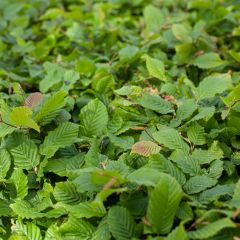
Carpinus betulus - Hornbeam
- Flowering time April to June
- Height at maturity 25 m
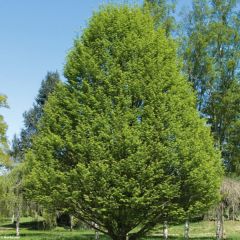
Carpinus betulus Fastigiata - Hornbeam
- Flowering time May, November
- Height at maturity 15 m

Carpinus betulus Orange Retz - Hornbeam
- Flowering time April to June
- Height at maturity 5 m
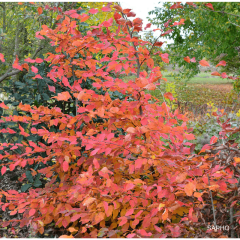
Carpinus betulus Rockhampton Red Lochglow - Hornbeam
- Flowering time April to June
- Height at maturity 20 m
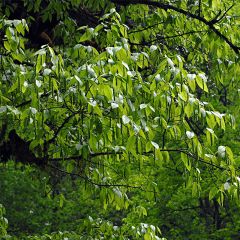
Carpinus fangiana - Monkey-tail Hornbeam
- Flowering time June, July
- Height at maturity 5 m
Discover other Carpinus - Hornbeam
View all →Available in 1 sizes
Available in 1 sizes
Available in 2 sizes
Available in 1 sizes
Available in 5 sizes
Available in 1 sizes
Available in 1 sizes
Available in 1 sizes
Available in 1 sizes
Available in 1 sizes
Young plantation
Where to Plant the Hornbeam?
The hornbeam is a hardy tree that simply appreciates deep, humus-bearing, rather cool and not too acidic soil. It can thrive in the shade of large oaks, so its placement alongside other trees in the garden or the shadow of a building is not a concern. If planted in isolation, just ensure that the sun is not too scorching. Soil dryness limits its growth and often leads to leaf drop or even the mortality of some branches.
When to Plant?
Preferably plant between November and March when there are no leaves. You can then obtain very young plants with bare roots, which are much less expensive than container-grown or balled plants.
Planting Distances
If you wish to create a hornbeam hedge, you will first need to estimate the number of plants required based on the desired density and height. For this, consider the following recommendations regarding planting distances:
- space the plants at least 70 cm apart for a dense hedge, which can be maintained between 1 m and 2-3 m in height,
- space the plants 1 to 1.50 m apart for a slightly less dense hedge, maintained between 2 and 4 m in height.
A hornbeam, when isolated, can spread up to 5 m wide. Plan for a distance of 5-6 m to form a copse. You can have a higher density at planting and then thin your copse to keep the best plants.
How to Plant?
Planting hornbeams generally poses no difficulties:
- If you are planting bare root plants, immediately after purchase, prepare a soaking mixture, which is a blend of 1/3 clay (or fine garden soil), 1/3 cow dung (or horse manure or potting soil), and 1/3 rainwater. Soak the roots in this mixture for 24 hours while you dig your holes. This precaution prevents root drying and stimulates recovery. Container-grown plants should simply be immersed in a bucket of water to thoroughly moisten the root ball. Note that a large plant sold in a ball should only be watered once planted to prevent the ball from falling apart. Be sure to remove any wire to avoid later strangulation of the roots.
- Dig a hole three times wider than the root ball, about 40 cm deep, and aerate the soil around it with a fork. For a hedge, create a trench 50 cm wide along the entire length of the hedge.
- Add a few shovelfuls of potting soil, compost, or crushed horn (150 g/m²) if the soil is not very dark (lacking humus).
- Place the plant in the planting hole, taking care not to bury the collar (the junction between the roots and the trunk).
- Replace the soil and lightly compact it, forming a basin to ensure proper watering of the plant.
- Pour approximately one watering can of 5 to 10 litres per plant.
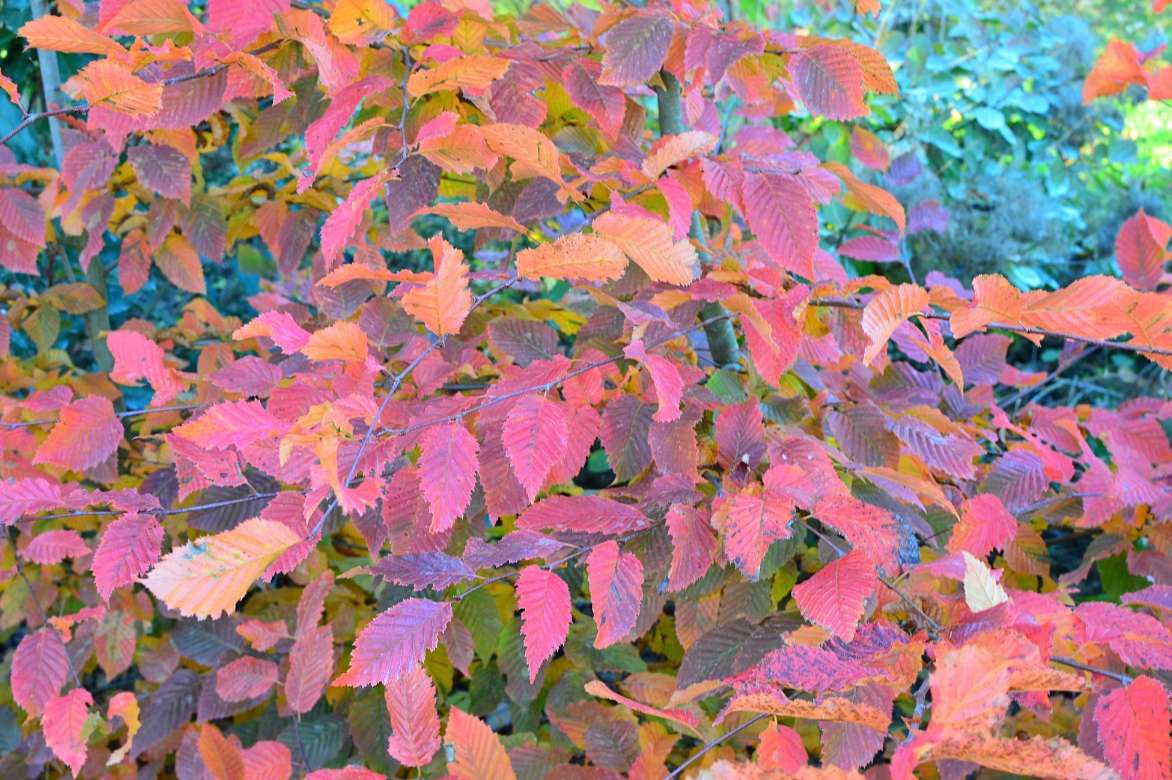
Stunning autumn foliage of Carpinus betulus ‘Rockhampton Red’ (©Sapho)
Read also
Birches: planting, pruning and careMaintenance and pruning of hornbeam and hornbeam hedges
Ensure that young plants do not suffer from drought during the first 2-3 years. Water each plant generously so that the water percolates well into the depth.
Hornbeam is durable and resistant to diseases.
Pruning Hornbeam, in Hedge or “Charmille”
For a hedge or “charmille”, start forming the branches by lightly pruning the shoots to encourage them to ramify and grow parallel to the hedge. You can stretch wires to train the branches.
Preferably carry out the pruning during the second half of September, or later in winter using pruning shears to clearly see the branches and then again in June to recalibrate the hedge if necessary. You can then use hedge trimmers. It is advisable to give a trapezoidal shape, meaning with a base slightly wider than the top when viewed from the side, so that the lower leaves receive sufficient light.
In Isolation
For a solitary specimen, gradually raise the branches to clear one or more trunks and simply remove any dead or damaged wood and branches that rub against each other. Operate during winter to better distinguish the branches.
Olivier tells you more in Hornbeam – charmille: when and how to prune?
Hornbeam can also be managed as a copse to provide firewood. The cutting back of the clumps is then carried out approximately every 10 to 25 years.
Multiplication of charm: propagation by cuttings, sowing
The most commonly used methods are sowing in spring after stratifying the seeds, propagation by cuttings in June or August, or even grafting for cultivars, which is the most complicated technique.
Propagation by Cuttings
Prepare a deep pot by filling it with potting soil mixed with sand.
For June Cuttings
- Take tips of herbaceous stems about 10 cm long, with a heel and at least 3 mature leaves.
- Remove the leaves near the base of the cutting, those at the tip that are not yet developed, and trim the remaining laminae.
- Insert them two-thirds of their length, ensuring they do not touch each other.
- Gently firm the soil around to eliminate air pockets and ensure good contact between the potting soil and the cutting.
- Place them in a humid environment in the shade, for example, by covering them with a cut transparent plastic bottle.
- In autumn, separate the rooted cuttings and plant them in buckets, keeping them under a frame until spring.
- Plant your plants in spring in the open ground.
For August Cuttings
- Make cuttings without a heel from semi-ripe stems about 15 cm long.
- Make a horizontal cut with a sharp grafting knife, just below a bud or a leaf that you remove.
Sowing
- Stratify the seeds, free of the wing, by placing them in a pot filled with sand, outdoors.
- Sow them in a seed tray filled with a light substrate in spring.
Uses and associations
Hornbeam forms a very decorative tree in isolation with its broad conical habit becoming quite ovoid with age. The fastigiate variety (Carpinus betulus fastigiata) has a more interesting pyramidal silhouette for creating an alignment limited to 4 m wide and 10 m high after 20-25 years. The cultivars ‘Rockhampton Red’ or ‘Orange Retz’, with their unique autumn foliage, deserve just as much recognition as a Parrotia, a maple, or a Liquidambar, to be showcased in isolation or within a grove accompanied by birches like Betula albosinensis ‘Fascination’, placed on the periphery for sunlight reasons, or within a bocage hedge that they will enliven until late in the season. The first offers orange-red hues with dimensions comparable to the type, while the second, much more compact (4 m by 3 m wide), turns to a blazing orange.

Examples of hornbeam use, pruned or in isolation (photos David Barrie/Leonora Enking-flickr)
However, hornbeam is also well-suited for monotypic hedges, known as “charmilles”, widely used in the gardens of the Sun King and which remain of unparalleled chic. It’s up to you to decide on the height and thickness! In a low hedge of 50 cm to 1 m, when the plants are still young, it helps organise space, marking the boundaries of a flowerbed without obscuring. Taller, it serves as a screen, windbreak, sunshade, or even a support for climbing or sarmentous roses like Ghislaine de Féligonde, Rosa moyesii ‘Geranium’… The orange dog roses should illuminate its golden branches until frost… The most common use is the traditional vegetative rooms that create the impression of a larger garden through well-managed partitions. The charmille serves as a neutral backdrop for a series of themed plantings that can be based on colour, garden style (Japanese, English, naturalistic, zen, gourmet…). It thus harmonises with all garden styles, from classic to modern.
Hornbeam remains an essential part of bocage hedges, free and natural, accompanied by oak, sweet chestnut (acidic soil), or field maple (calcareous soil), welcoming both birds and beneficial insects useful for crops.
Did you know?
The genus Carpinus is a Latin name composed of two words of Celtic origin, karr, meaning wood, and penn, head, referring to the use of Hornbeam wood for making yokes for oxen.
To go further
- Discover our range of Hornbeams.
- To prevent, identify, and treat: Diseases and parasitic issues of Hornbeams
- Subscribe!
- Contents
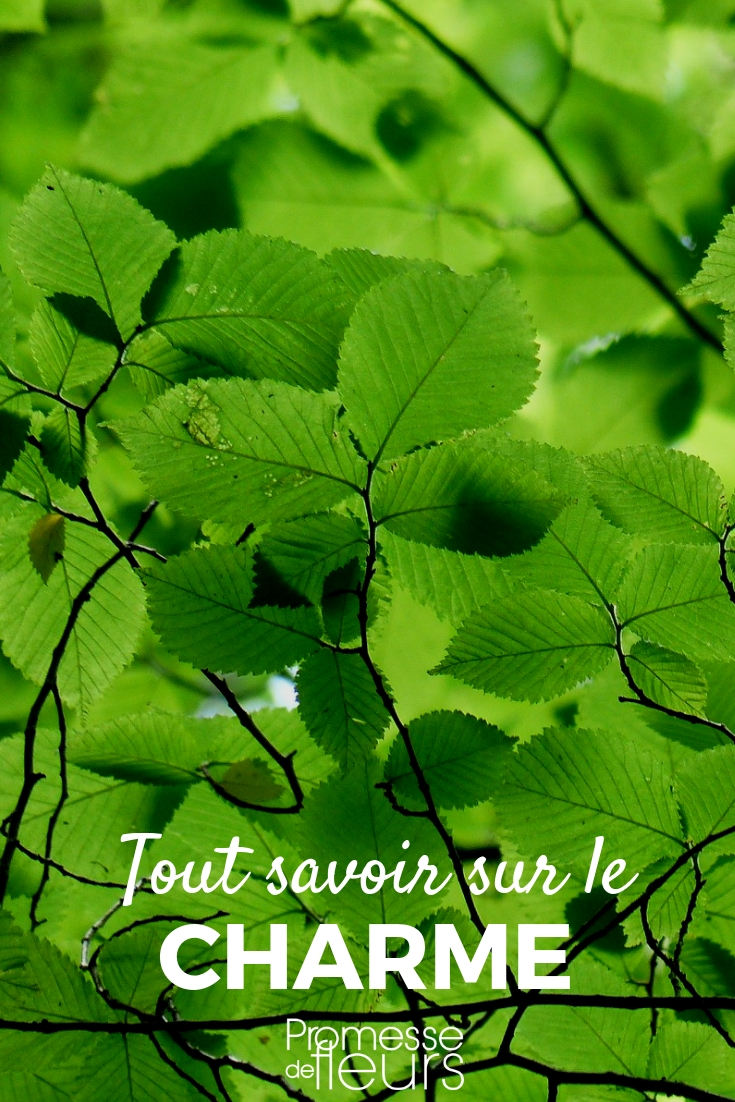
































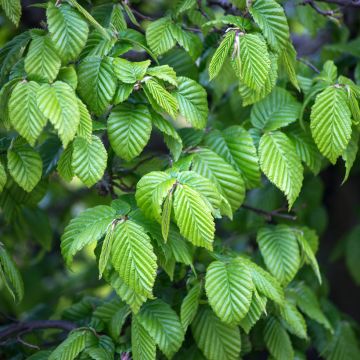

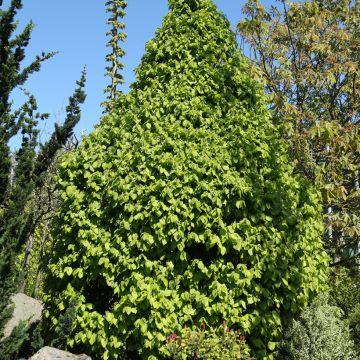

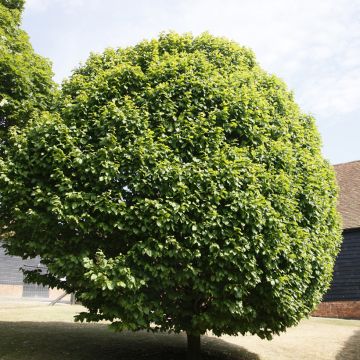
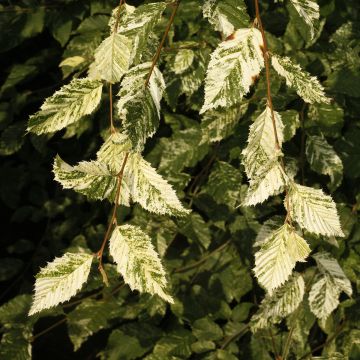
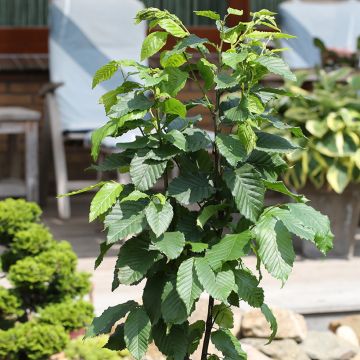

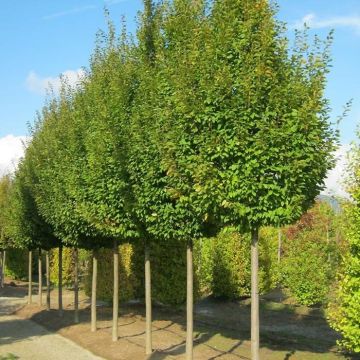
Comments